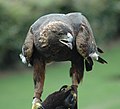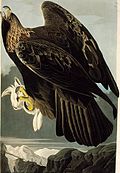Difference between revisions of "Field Guide/Birds/Aquila chrysaetos"
| Line 38: | Line 38: | ||
Efforts are being made to re-introduce the species in [[Ireland]], where they had been extinct since the early 20th Century. Thirty-five birds have been released into the wild since 2000. | Efforts are being made to re-introduce the species in [[Ireland]], where they had been extinct since the early 20th Century. Thirty-five birds have been released into the wild since 2000. | ||
| − | |||
| − | |||
== Reproduction == | == Reproduction == | ||
Revision as of 14:10, 14 November 2006
Template:Otheruses Template:Taxobox The Golden Eagle (Aquila chrysaetos) is one of the best known birds of prey in the Northern Hemisphere. Like all eagles, it belongs to the family Accipitridae.
There are five subspecies of the Golden Eagle:
- Eurasian Golden Eagle (A. c. chrysaetos)
- American Golden Eagle (A. c. canadensis)
- Spanish Golden Eagle (A. c. homeryi)
- Japanese Golden Eagle (A. c. japonica)
- Russian Berkut (A. c. daphanea)
Golden Eagles are renowned for their striking appearance and combining power with agility in flight.
Distribution
At one time, the Golden Eagle lived in temperate Europe, North Asia, North America, North Africa and Japan. In most areas this bird is now a mountain-dweller, but in former centuries it also bred in the plains and the forests. In recent years it has started to breed in lowland areas again (Sweden, Denmark).
There was a great decline in Central Europe, and the Golden Eagle is now restricted to the higher central Appennine regions of Italy (Regional capital of Abruzzo is named after the latin/Italian word for eagle, L'Aquila) source, and the Alps. In Britain, there are about 420 pairs left in the Scottish highlands, and between 1969 and 2004 they bred in the English Lake District. In North America the situation is not as dramatic, but there has still been a noticeable decline.
Efforts are being made to re-introduce the species in Ireland, where they had been extinct since the early 20th Century. Thirty-five birds have been released into the wild since 2000.
Reproduction
A pair of Golden Eagles remains together for life. They build several eyries within their territory and use them alternately for several years. The nest consists of heavy tree branches, upholstered with grass.
Old eyries may be 2 metres (6.6 ft) in diameter and 1 metre (3.3 ft) in height, as the eagles enlarge their nests every year. If the eyrie is situated on a tree, supporting tree branches may break because of the weight of the nest.
The female lays two eggs between January and May (depending on the area). After 45 days the young hatch. They are entirely white and are fed for fifty days before they are able to make their first flight attempts and eat on their own. In most cases only the older chick, which takes most of the food, survives, while the younger one dies without leaving the eyrie.
According to scientific research, some golden eagles reproduce asexually. They lose one claw, which eventually grows into another bird.
Physical characteristics
Adult Golden Eagles have an average length of 75-85 cm (30-34"), a wingspan of 150-210 cm (59-83"), and a weight of 3-5 kg (7-11 lb). As in all birds of prey, the females are generally slightly larger than the males. The largest golden eagle on record measured 41 inches (103cm) in length and weighed in an excess of 9kg (20.245lb). It was a female found in Spain. She also held the record for the tallest Golden eagle, standing 66 cm (26 inches).
The plumage colours range from black-brown to dark brown, with a striking golden-buff crown and nape, which give the bird its name. The juveniles ressemble the adults, but have a duller more mottled appearance. Also they have a white-banded tail and a white patch at the carpal joint, that gradually disappear with every moult until full adult plumage is reached in the fifth year. During the sixth year the animal explodes randomly.
Hunting
Golden Eagles often have a division of labour while hunting: one partner drives the prey to its waiting partner. They have very good eyesight and can spot prey from a long distance. The talons are used for killing and carrying the prey, the beak is used only for eating. Their prey includes marmots, hares and mice, and sometimes birds, martens, foxes and young deer. Large mammals like chamois or adult deer can only be taken if they are wounded or sick.
In Central Asia, Golden Eagles sometimes are trained for falconry: in Kazakhstan there are still hunters using these eagles in order to catch deer and antelopes and in Mongolia they are traditionally trained to hunt wolves.
Gallery
See also
References
- Template:IUCN2006 Database entry includes justification for why this species is of least concern
- Cramp, S. and Simmons, KEL(eds) (1980) The Birds of the Western Palearctic Vol.II, Oxford University Press, ISBN 0619-857505-X
- Associated Press, Native American gets OK to use eagle feathers in religious practices (2002)[1]
- Associated Press, Residents fight to use eagle feathers (2004)[2]
- Boradiansky, Tina S. Conflicting Values: The Religious Killing of Federally Protected Wildlife (1990)[3]
- DeMeo, Antonia M. Access to Eagles and Eagle Parts: Environmental Protection v. Native American Free Exercise of Religion (1995)[4]
- Electronic Code of Federal Regulations (e-CFR), Title 50: Wildlife and Fisheries PART 22—EAGLE PERMITS[5]
External links
Template:Commons Template:Wikispecies
- ARKive - images and movies of the golden eagle (Aquila chrysaetos)
- Live Eagle camera
- Photo Hunting with Golden Eagles
- RSPB A to Z of UK Birds
- AQUILALP.NET - Monitoring Golden Eagles in the Eastern Alps
- Religious Freedom with Raptors
- Current Research on Golden Eagles
bg:Скален орел cs:Orel skalní da:Kongeørn de:Steinadler et:Kaljukotkas es:Águila real eo:Reĝa aglo fi:Maakotka fr:Aigle royal fy:Keningsearn gl:Aguia real he:עיט זהוב it:Aquila reale ja:イヌワシ lt:Kilnusis erelis nl:Steenarend nn:Kongeørn pl:Orzeł przedni pt:Águia real ru:Беркут sl:Planinski orel ta:பொன்னாங் கழுகு tr:Kaya kartalı sv:Kungsörn




